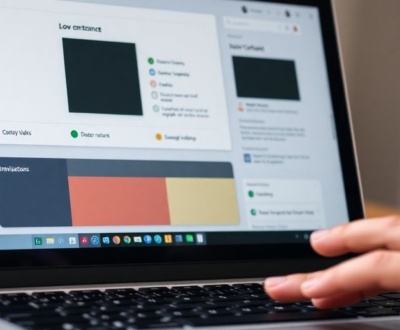Creating a design system that works for many brands can seem tricky. Each brand has its own look, right? But if you want things to stay consistent and work well across all your products, especially with different brands, you need a smart way to do it. That’s where design tokens come in handy. They help make sure everything looks right, no matter the brand, and they make life easier for both designers and developers. This article will walk you through how design tokens in multi-brand systems can really make a difference.
Key Takeaways
- Design tokens help keep things looking the same across different brands, even when each brand has its own style.
- Using tokens means you can change colors or fonts in one spot, and it updates everywhere, which saves a lot of time.
- Tokens help make sure designers and developers are on the same page, making the whole process smoother.
- Setting up your tokens well from the start makes it easier to add new brands or update existing ones later.
- When you use tokens, you can get new products or updates out faster because you’re not starting from scratch every time.
Understanding Design Tokens in Multi-Brand Systems

Defining Design Tokens for Scalability
Okay, so what are design tokens, really? Think of them as the DNA of your design system. They’re not just colors or fonts; they’re named entities that store visual design attributes. This means instead of hard-coding a specific hex code for a button’s background, you’d use a token like button-primary-background. This abstraction is what makes scaling across multiple brands possible. It’s about creating a single source of truth for your design language.
- Centralized management of styles.
- Consistent application of design decisions.
- Easier updates and modifications.
Components Versus Brand Themes
It’s helpful to think of your design system in two distinct parts: components and brand themes. Components are the reusable building blocks – buttons, forms, navigation bars – that make up your user interface. Brand themes, on the other hand, are the sets of styling information that are specific to each brand. Design tokens act as the bridge between these two. Components reference tokens, and tokens are defined differently for each brand theme. This way, you can use the same component across multiple brands, but it will look and feel different based on the brand’s theme. This approach helps in creating a multi-brand enterprise design system.
The Role of Tokens in Theming
Tokens are the key to easy theming. They allow you to change the look and feel of your entire design system by simply modifying the token values. For example, if you want to change the primary color for one brand, you just need to update the primary-color token in that brand’s theme. All components that use that token will automatically update. This is way easier than having to go through and change every single instance of that color manually. It also helps maintain consistency, because you’re always using the same set of tokens, even if their values are different.
Think of tokens as variables in code. You define them once, and then you can use them throughout your design system. When you need to make a change, you only need to update the variable, and all instances of it will automatically update. This makes it much easier to maintain and scale your design system across multiple brands.
Structuring Design Tokens for Multi-Brand Systems
Organizing Components for Scalability
When you’re dealing with multiple brands, the way you organize your components becomes super important. It’s not just about making things look pretty; it’s about making them adaptable. Think of your components as building blocks. They need to be flexible enough to fit into different brand aesthetics without requiring a complete overhaul each time. A well-structured component library is the backbone of a scalable multi-brand design system.
Here’s a simple way to think about it:
- Core Components: These are your basic, brand-agnostic elements like buttons, inputs, and labels. They should have minimal styling.
- Brand Themes: These are sets of styling rules (colors, typography, etc.) that get applied to the core components.
- Component Variants: These are variations of core components with specific functionalities or states (e.g., a primary button vs. a secondary button).
By separating the core functionality from the brand-specific styling, you can easily switch themes without breaking the underlying component.
Establishing a Universal Token Identifier
Imagine trying to manage hundreds of design tokens without a clear naming system. It would be chaos! That’s why establishing a universal token identifier is so important. Think of it as giving each token a unique and easily understandable name. This makes it easier to track, update, and maintain your tokens across different brands.
For example, instead of naming a color token "BrandA_ButtonColor", you might use a more generic name like "color.button.primary". The brand-specific value for that token would then be defined in the brand’s theme file. This approach ensures that the token’s purpose is clear, regardless of the brand it’s being used in. This is how you can utilize design tokens for easy theming.
Documenting Token Roles and Values
Documentation is key. It’s not enough to just have a bunch of tokens; you need to know what they’re for and how they’re supposed to be used. This means documenting the role of each token (e.g., "used for primary button background") and its possible values (e.g., hex codes, color names). This documentation serves as a single source of truth for designers and developers, ensuring that everyone is on the same page.
Here’s what your token documentation might include:
- Token Name: The universal identifier (e.g.,
color.button.primary). - Description: A clear explanation of the token’s purpose.
- Values: The brand-specific values for each theme (e.g.,
#007bfffor Brand A,#28a745for Brand B). - Usage: Examples of how the token is used in components.
| Token Name | Description | Brand A Value | Brand B Value | Usage |
|---|---|---|---|---|
color.button.primary |
Background color for primary buttons | #007bff |
#28a745 |
<Button primary /> |
font.size.base |
Base font size | 16px |
18px |
body { font-size: ... } |
spacing.small |
Small spacing unit | 8px |
12px |
margin: ... |
Implementing Design Tokens in Multi-Brand Systems
Utilizing Tokens for Easy Theming
Design tokens really shine when it comes to theming. Imagine you have a component, like a button. Instead of hardcoding the button’s color, you reference a color token, like $color-primary. When you need to change the button’s color for a different brand, you simply update the value of $color-primary in that brand’s theme file. This approach ensures consistency and reduces the risk of errors. Think of it like this:
- Define your core components.
- Reference design tokens for styling.
- Create brand-specific theme files with token values.
This way, you can easily switch between themes without modifying the underlying component code. It’s all about abstraction and reusability.
Connecting Design Files with Development
Getting design tokens from your design tool (like Figma) into your code base is a critical step. There are a few ways to do this. One popular method is to use plugins like Tokens Studio, which allows you to manage your tokens in Figma and then export them in a format that developers can use, such as JSON. Another approach involves using the Figma API to extract token values programmatically.
The key is to establish a clear and automated pipeline. This ensures that changes made in the design tool are reflected in the code, and vice versa. This connection is vital for maintaining a single source of truth and preventing discrepancies between design and development.
Here’s a simple table illustrating the options:
| Method | Pros | Cons |
|---|---|---|
| Tokens Studio | Easy to use, supports multiple export formats, good for collaboration | Requires a plugin, might have limitations depending on the complexity |
| Figma API | Highly customizable, allows for complex transformations | Requires coding knowledge, more setup and maintenance |
Automating Token Workflows
Automation is your friend when dealing with design tokens, especially in a multi-brand context. Manually updating token values across multiple files and platforms is a recipe for disaster. Instead, look for ways to automate the process. This might involve using scripts to transform token data, setting up CI/CD pipelines to automatically deploy token changes, or using tools that provide built-in automation features. For example, you can use open-source component libraries to automate the process of generating code from your design tokens.
Consider these steps for automating your token workflow:
- Choose a token management tool (e.g., Tokens Studio, Specify).
- Set up a repository to store your token data (e.g., JSON files in Git).
- Create scripts to transform and distribute tokens to different platforms.
- Integrate the token pipeline into your CI/CD system.
By automating these steps, you can significantly reduce the effort required to manage your design tokens and ensure that they are always up-to-date across all your brands. This will increase efficiency & efficacy in the long run.
Operationalizing Design Tokens in Multi-Brand Systems
From Design Choices to Design Decisions
It’s easy to fall into the trap of making arbitrary design choices, especially when dealing with multiple brands. Design tokens help turn these choices into actual design decisions. Instead of just picking a color, you’re defining a token like $button-primary-background which has a specific role and purpose. This makes the system more maintainable and understandable.
Governance Processes for Token Development
Like any important aspect of a design system, token development needs a governance process. This doesn’t have to be overly complicated, but it should involve collaboration and discussion. Think of it as a shared responsibility among the product team. It’s about creating a shared understanding and allowing for expansion, especially when the system is new. Consider these points:
- Establish a clear process for proposing new tokens.
- Define roles and responsibilities for token maintenance.
- Regularly review and update tokens to ensure they meet current needs.
Having a governance process ensures that tokens are created and maintained in a consistent and thoughtful way, preventing the system from becoming chaotic and unmanageable.
Storing Tokens in JSON for Cross-Platform Use
Once you’ve defined your tokens, you need a way to store and distribute them. JSON (JavaScript Object Notation) is a great choice because it’s a simple, human-readable format that can be used across different platforms. JSON allows you to share tokens not only across websites but also across different platforms. This is key for maintaining consistency in a multi-brand environment. Here’s a basic example:
{
"color": {
"primary": {
"value": "#007bff",
"comment": "Primary brand color"
},
"secondary": {
"value": "#6c757d",
"comment": "Secondary brand color"
}
}
}
Using JSON makes it easier to automate token workflows and integrate them into your development process.
Benefits of Design Tokens in Multi-Brand Systems
Achieving Consistency Across Brands
Design tokens are a game-changer for maintaining a uniform look and feel across different brands. It’s like having a master control panel where you can tweak the visual elements and have those changes ripple through all your brands. This is especially useful when you want to ensure that even with different brand identities, there’s a sense of cohesion and trust. Think of it as ensuring that while each brand has its own unique flavor, they all adhere to the same high standards of quality and user experience. This is achieved by using design tokens to define the visual style.
Increasing Design and Development Efficiency
Design tokens seriously cut down on the time and effort needed for both design and development. Instead of manually adjusting colors, fonts, and spacing for each brand, you can simply update the tokens, and the changes propagate automatically. This not only saves time but also reduces the risk of errors and inconsistencies. It’s like having a well-oiled machine where everyone is on the same page, using the same language, and working towards the same goals. This efficiency boost translates to faster project turnaround times and lower costs.
Accelerating Time to Market
With design tokens, you can launch new brands or update existing ones much faster. The ability to quickly adapt and modify the visual elements means you can respond to market changes and customer demands more effectively. It’s like having a secret weapon that allows you to stay ahead of the competition and seize new opportunities. This speed and agility are crucial in today’s fast-paced business environment, where time is of the essence. By using a multi-brand design system, you can quickly adapt to market changes.
Design tokens help turn design choices into design decisions. Instead of debating the merits of a particular shade of blue for each brand, you can define a token for a specific purpose (e.g., primary button color) and then assign different values to that token for each brand. This not only speeds up the design process but also ensures that the design decisions are aligned with the overall brand strategy.
Maintaining Design Tokens in Multi-Brand Systems

Ensuring Token Consistency Across Themes
Maintaining consistency is key when dealing with design tokens across multiple brands. Each token should serve the same purpose across all themes, even if the actual value changes. Think of it like this: a ‘primary-button-color’ token should always define the main color for buttons, regardless of whether it’s blue for Brand A or green for Brand B. If you start using ‘primary-button-color’ for something else in one brand, you’re asking for trouble.
To help with this, consider:
- Using naming conventions that clearly define the token’s purpose.
- Documenting the intended use of each token.
- Regular audits to ensure tokens are being used as intended.
Managing Updates and Changes Effectively
Updates are inevitable, but how you handle them can make or break your design system. A well-defined process is essential. Before making changes, consider the impact on all brands. Will this update affect accessibility? Will it clash with any brand-specific guidelines?
Here’s a simple process:
- Propose the change: Clearly outline what you want to change and why.
- Assess the impact: Evaluate how the change will affect each brand.
- Test the change: Implement the change in a test environment and get feedback.
- Communicate the change: Let everyone know about the update before it goes live.
- Monitor the change: Keep an eye on things after the update to make sure everything is working as expected.
Collaborative Development for Shared Understanding
Design tokens shouldn’t be the responsibility of just one person or team. It’s a shared effort that requires collaboration between designers, developers, and brand stakeholders. Encourage open communication and feedback throughout the token development process. This helps ensure that everyone understands the purpose of each token and how it should be used.
Having a shared understanding of design tokens can prevent inconsistencies and ensure that everyone is working towards the same goal. Regular meetings, shared documentation, and open communication channels are all essential for successful collaborative development.
Consider using tools that facilitate collaboration, such as shared design libraries, version control systems, and communication platforms. The goal is to create a transparent and inclusive environment where everyone feels empowered to contribute to the design token system.
Wrapping Things Up
So, that’s the gist of it. Using design tokens across different brands really helps keep things organized and makes sure everything looks right. It’s not just about making pretty designs; it’s about making sure those designs work well and stay consistent, no matter how many brands you’re dealing with. It takes a bit of planning upfront, but trust me, it pays off big time in the long run. You’ll save yourself a lot of headaches and keep your design system running smoothly. It’s a smart way to work, plain and simple.
Frequently Asked Questions
What are design tokens, and how do they help with many brands?
Design tokens are like special labels for design choices, such as colors, fonts, and spacing. In systems with many brands, they help keep things looking the same across all brands while still letting each brand have its own style.
What’s the difference between components and brand themes?
Think of it this way: components are like building blocks (buttons, menus), and brand themes are the paint and decorations you put on them. Design tokens are the instructions that tell the building blocks what paint and decorations to use for each brand.
How do you keep design tokens consistent across different brands?
We make sure each token has a clear name that doesn’t change, no matter the brand. This way, a ‘primary color’ token always means the main color, even if the actual color is red for one brand and blue for another.
Can design tokens make it easier to change a brand’s look?
Yes! Design tokens make it easy to change the look of a brand quickly. If a brand wants a new shade of blue, you just update the token, and all parts of the design that use that token will change automatically.
How do design tokens help designers and developers work together?
When designers and developers use the same design tokens, it’s like they’re speaking the same language. This helps them work together better and faster, making sure the final product looks just like the design.
Where are design tokens stored, and why is that important?
We store design tokens in a simple text format called JSON. This makes it easy for different computer programs and systems to understand and use them, whether it’s for a website, an app, or something else.
About this blog
We are a digital marketing company with a focus on helping our customers achieve great results across several key areas.
Request a free quote
We offer professional SEO services that help websites increase their organic search score drastically in order to compete for the highest rankings even when it comes to highly competitive keywords.









